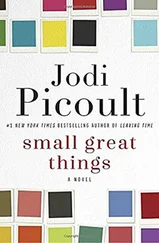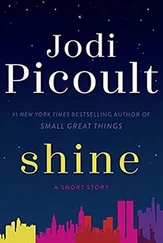We were not alone inside. To my right was a woman about ten years older than I was, pushing one of those state-of-the-art wheelchairs with a child sprawled across it. This one was a boy in his teens, thin and angular, his head supported by a brace on the back of the chair. His elbows twisted, so that his arms were flailed outward; his glasses were askew on the bridge of his nose. His mouth was open, and his tongue-thick and jellied-filled the bowl of his mouth. “Aaaaah,” the boy sang. “Aaaaah!”
His mother touched her hand to his cheek. “Yes, that’s right.”
I wondered if she really understood what he was trying to say. Was there a language of loss? Did everyone who suffered speak a different dialect?
I found myself staring at the woman’s fingers, stroking her son’s hair. Did this boy know his mother’s touch? Did he smile at her? Would he ever say her name?
Would you?
Sean reached for my hand and squeezed it tightly. “We can do this,” he whispered. “We can do it together.”
I didn’t speak until the elevator stopped at floor three and the woman pushed her son’s wheelchair off into the hallway. The doors sealed shut again, isolating Sean and me in a vacuum. “Okay,” I said.
“Tell us about Willow’s birth,” Marin said, pulling me back to the present.
“She was early. Dr. Del Sol had scheduled a C-section, but instead, I went into labor and everything happened very quickly. When she was born, she was screaming, and they took her away from me to X-ray her, to do tests. It was hours before I saw Willow, and when I did, she was lying on a foam pad in a bassinet, with bandages wrapped around her arms and legs. She had seven healing fractures and four new breaks caused by the birth.”
“Did anything else happen in the hospital?”
“Yes, Willow broke a rib, and it pierced her lung. It was…it was the most frightening thing I’ve ever seen in my life. She went blue, and suddenly there were dozens of doctors in the room and they started doing CPR and stuck a needle in between her ribs. They told me her chest cavity had filled with air, which made her heart and trachea shift to the wrong side of her body, and then her heart had stopped beating. They did chest compressions-breaking even more of her ribs-and put in a chest tube to make the organs go back where they belonged. They cut her,” I said. “While I watched.”
“Did you talk to the defendant afterward?” Marin asked.
I nodded. “Another doctor told me that Willow had been without oxygen for a while, and that we wouldn’t know if there would be brain damage. He suggested that I sign a DNR form.”
“What’s that?”
“It means do not resuscitate. If anything like this happened to Willow again, the doctors wouldn’t intervene. They’d let Willow die.” I looked into my lap. “I asked Piper for advice.”
“Because she was your physician?”
“No,” I said. “Because she was my friend.”
I had failed.
That’s what I thought, when I looked down at you, battered and buttressed, a fountain of a chest tube blooming out from beneath your fifth rib on the left side. I had been asked by my best friend to help her conceive, and this was the outcome. After the wrenching question about whether or not you belonged in this world, it seemed that you were giving Charlotte your own answer. Without saying a word, I walked up to Charlotte, who was staring down at you as you slept, as if glancing away for even a moment might give you incentive to code again.
I had read your chart. The fractured rib had caused an expanding pneumothorax, a mediastinal shift, and cardiopulmonary arrest. The resultant intervention had caused nine further fractures. The chest tube had been inserted through the fascia and into the pleural space of your chest, sutured into place. You looked like a battlefield; the war had been fought on the broken ground of your tiny body.
Without saying a word, I walked up to Charlotte and reached for her hand. “Are you okay?” I asked.
“I’m not the one you need to worry about,” she replied. Her eyes were red-rimmed; her hospital robe askew. “They asked if we wanted to sign a DNR.”
“Who asked that?” I had never heard of anything so stupid. Not even Terri Schiavo had been made DNR until tests indicated severe, irreversible brain damage. It was hard enough to get a pediatrician to be hands off when dealing with a severely preterm fetus with a high probability of death or lifetime morbidity-to suggest a DNR for a neonate on whom they’d just done the full-court press in terms of a code seemed improbable and impossible.
“Dr. Rhodes-”
“He’s a resident,” I said, because that explained everything. Rhodes barely knew how to tie his shoes, much less talk to a parent who’d been through an intense trauma with a child. Rhodes should never have brought up the DNR to Charlotte and Sean-particularly since Willow hadn’t yet been tested to see if she was mens sana. In fact, while he was ordering that test, he might have wanted to get one for himself.
“They cut her open in front of me. I heard her ribs break when they…when they…” Charlotte’s face was white, haunted. “Would you sign one?” she whispered.
She had asked me the same question, in not so many words, before you were even born. It was the day after her twenty-seven-week ultrasound, when I had sent her to Gianna Del Sol and the health-care team for high-risk pregnancies at the hospital. I was a good obstetrician, but I knew my limits-and I couldn’t provide her with the care she now needed. However, Charlotte had been traumatized by a stupid geneticist whose bedside manner was better suited to patients already in the morgue, and now I was doing damage control while she sobbed on my couch.
“I don’t want her to suffer,” Charlotte said.
I did not know how to tiptoe around the topic of a late-term abortion. Even someone who wasn’t Catholic, like Charlotte, would have a hard time swallowing that option-and yet, it was never chosen lightly. Intact D & Es were performed only by a handful of physicians in the country, physicians who were highly skilled and committed to ending pregnancies where there was a great maternal or fetal health risk. For certain conditions that weren’t apparent before the twelve-week cutoff for abortions, these doctors provided an alternative to giving birth to a baby with no chance of survival. You could argue that either outcome would leave a scar on the parent, but then again, as Charlotte had pointed out, there were no happy endings here.
“I don’t want you to suffer,” I replied.
“Sean doesn’t want to do it.”
“Sean isn’t pregnant.”
Charlotte turned away. “How do you fly across the country with a baby inside you, knowing you’ll be coming back without one?”
“If it’s what you want, I’ll go with you.”
“I don’t know,” she sobbed. “I don’t know what I want.” She looked up at me. “What would you do?”
Two months later, we stood on opposite sides of your hospital NICU bassinet. The room, filled with so many machines to keep their tiny charges alive and functional, was bathed in a rich blue light, as if we were all swimming underwater. “Would you sign one?” Charlotte asked me again, when I didn’t answer the first time.
You could argue that it was less traumatizing to terminate a pregnancy than it was to sign a DNR for a child who was already in this world. Had Charlotte made the decision to terminate at twenty-seven weeks, her loss would have been devastating but theoretical-she would not have met you yet. Now, she was forced to question your existence again-but this time, she could see the pain and suffering in front of her eyes.
Charlotte had come to me for advice multiple times: about conceiving, about whether or not to have a late-term abortion, and now, about a do not resuscitate order.
Читать дальше












